If there was ever a time to write about Skull The Slayer, the time is probably now. Yes, that’s right. Forty years after the debut of the character’s short-lived Marvel series? That’s when we need to sit down and talk about a little known fourth-rate character dearly loved by a select few (in part because he’s little known and fourth-rate).
The time is now to talk because the character has sort of/kind of returned in the third issue of Jason Aaron and Mike Del Mundo’s Weirdworld, which means Marvel released a ridiculously expensive trade paperback collecting what you could call the entire arc of the character—all eight issues of his series, and a two issue wrap-up in Marvel Two In One a few years later—which also means digital versions of both the collection and the individual issues hit Comixology.
(Which also means I bought them as soon as I figured that out.)
[And pro-tip: if you have access to the Kindle app or the full-color Kindle tablets, you can get the Kindle version of the trade for $9.99…which is a dollar an issue and half the price I spent. Normally, I’m leery about recommending the Kindle app because I learned the hard way it’s not great with double page spreads, but there’s literally one of those in the entire ten issues. ]
Anyway! Yes, there truly has never been a better time to talk about a little known fourth-rate Marvel character…except maybe ten years from now, when Marvel turns the character into a startlingly successful motion picture franchise. Until that happens, however, join me after the the jump for the first part of the preamble to that discussion, won’t you?
First, let’s get the easy stuff out of the way. The protagonist of Skull The Slayer is (unsurprisingly) Skull The Slayer, a.k.a. Jim Scully, a former air force captain who, as the book opens, is being flown from Bermuda to Miami to face trial for murder. Scully, who was shot down on his first mission in Viet Nam, captured as a prisoner of war and tortured intermittently for five years before being released, had returned to an America with no place for him: his wife has divorced him and taken up with another man; his parents died worrying about him, and his younger brother became a homicidal drug addict. It is the murder of his brother for which Scully has been arrested.
Fortunately for Scully, a ’70s fad intervenes, and the plane carrying Scully, his captors, and a few civilians (Ann Reynolds, Dr. Raymond Corey, and teenager Jeff Turner) are pulled into the mysterious Bermuda Triangle to emerge in the good ol’ land that time forgot. After the plane splits in two (why hello there, Lost!), the only survivors (Scully and the trio of civilians) must fight to survive in a savage land that appears to be their own past. And, of course, Scully, a man out of time, learns he’s perhaps better suited to hunting game and killing dinosaurs than he was in the America of the ’70s. (I do love that “Greetings!” caption of the bottom of the page above—as fans of early DePalma know, that was the first word on the draft summons during the Vietnam era—it’s a tip that Skull is about to enter a surreal version of that war, one for which he’s better suited.)
And that—give or take a T. Rex death or two—is the plot of the first issue, and upon re-reading it for the first time in a decade or two, I gotta say: it’s a good book.
Walking into this whole venture, my biggest concern was discovering my love for the character had everything to do with that strange kinship that can develop between lonely comic book reader and lonely comic book hero. After all, I read a ton of Marvel Comics in the ’70s (from about ’75 to ’80, I easily read the majority of the Marvels from that time) so why did I decide, at some point, to pick Skull as one of my very faves, as opposed to, say, Killraven or The Son of Satan, or Iron Fist or The Black Panther or any of the members of the All-New Uncanny X-Men? Was there anything to the choice other than the pride of the True Fan, a pick that’s a secret handshake only recognizable to other True Fans?
For the few issues at least? Yes. In a happy bit of synchronicity, my recent review here for Star Trek/Planet of the Apes gave me the opportunity to muse on POTA, and most especially the voice of Charlton Heston’s Taylor, simultaneously specific in tone while general in its misanthropy. Writer/creator Marv Wolfman narrates the first issue in a third-person voice of Scully’s point of view which is remarkably similar to Taylor’s. Here’s the narration from a panel where Scully comes face to face with a T. Rex:
SCULLY: Mother of mercy! I don’t believe it!
CAPTION: Believe it, baby—’cause there it stands—forty feet long and seventeen high.
CAPTION: Tyrannosaurus Rex—the tyrant lizard.
CAPTION: And brother—you better believe it’s earned its name.
So, yeah, knowingly or not–and I suspect it’s pretty damn knowing, since the also book wastes no time in settling characters down to talk about time paradoxes–Wolfman has crafted a genre work trafficking in a specialty of the ’70s: a disgust for the present, where the creator carps on suburban sprawl, urban decay, and the trite meaninglessness of modern culture. (“Hey, man–got good and bad news for you,” a caption declares at one point. “Bad first: you missed the ‘Tonight Show with Special Guest Host, Joey Bishop.’ Good news: you’re gonna keep missing it.”)
What makes this tone specific to the ’70s though is the sorrow veined throughout the sardonicism. In the pre-credit sequence to Planet of the Apes, Taylor confesses to the flight recorder, “I leave the 20th Century with no regrets,” before adding, “Time bends. Space is boundless. It squashes a man’s ego. I feel lonely.” That moroseness—which you can find in Planet of the Apes, the fiction of Harlan Ellison and throughout genre fiction of the time—pervades the decade, especially before America re-minted itself at its Bicentennial and George Lucas’s cosmic fairy tale showed Heston’s sour dystopias the door. The American longing to escape to the frontier still propelled genre fiction forward but, like so much else in the ’70s, it was poisoned, shivering with doubt and fatalism. When we couldn’t suspend our belief enough to see ourselves as heroes, the anti-hero stepped to the fore, and that transition perfectly suited Marvel, where the heroics usually came with a generous dash of self-loathing.
Also especially pleasing in the first issue is the work of Steve Gan, a Filipino artist of Chinese heritage. Like other Filipino artists making their mark in the American comics industry, Gan put a lot of linework on his pages, many of them surprisingly delicate, bolstered by a judicious use of blacks and rock-solid anatomy.
Unfortunately, part of what makes Gan so great in the first issue is how much he gets wrong. Like Skull, Gan is entirely comfortable in the military scenes, where uniforms are correct and photo reference is easy (okay, he kinda screws up the stock on an M-16 but that’s pretty minor) and incredibly lost in his scenes of civilian life, where Scully’s ex-wife is wearing a dress with crazily embroidered sleeves, Scully’s brother lounges about in blue pajamas and boots, and there are a suspiciously high number of ascots among the civilians aboard the plane. Admittedly, I wasn’t the most fashion-conscious nine year old but it was different enough from what I saw on the street and on TV that it worked on a subliminal level. In Gan’s hands, the America Skull returns to for just a few panels seems…different.
According to the text page from the first issue (absent from the Comixology issue and, presumably, the collection), in Wolfman’s original idea for the book, an entire mid-town Manhattan office building gets cast into a prehistoric setting but the idea was turned down at DC, where it was first pitched, because “the concept of a series which progressed from issue to issue was frowned upon. No continued plotlines, much less stories.”
But at Marvel, Wolfman had better luck pitching Thomas who was also a dinosaur buff but who believed “the apartment house idea was not feasible. It would spread the focus of our plots too thin, and, to be a commercially successful book, it would not have one solid star [….] and past sales indicated that one strong star makes for a winner.”
(In case you’re wondering, Kazuo Umezu’s The Drifting Classroom, in which an entire school gets cast into a seemingly prehistoric setting, first appeared in 1972. Although the majority of the story is told from the point of view of Sho, a sixth grader, he’s not exactly what you would call “one solid star.” But that’s only one of the many differences between the American and Japanese comics markets, and—since Umezu shares the copyright for The Drifting Classroom which has been adapted several times into different media but Wolfman lost his rights in a lawsuit to Skull, Blade, and other characters he created for Marvel—not even the saddest one).
Again, like the plane being split in half in mid-air, I can’t help but think of Lost when I consider the idea of an entire office building thrown back into time, especially as Wolfman intended to layer in secondary plots featuring the cavemen already there (The Others!), other time periods (the flashbacks!), and a cosmic dinosaur series (doesn’t sound any worse than how all that Jacob stuff played out!).
Unfortunately, reading the first three Wolfman-scripted issues of Skull The Slayer, one can sense how out of his league Wolfman might’ve been with so many characters, as he can’t scrape more than a serviceable cliche for his Skull’s three companions. As Jeff, the teen, puts it in the second issue: “I’ve got a domineering father—he’s a senator who thinks he owns me! So I ran away and he sent half the armed forces to bring me back! You, Dr. Corey! I overhead you on the plane! You think every white man’s out to put you down! So you put them down first!”
(Ugh.)
As for Ann Reynolds, “I became top in my class, but what did it get me? When I applied for a job, I was told they don’t hire young girls because we’d be trained and then we’d leave with a year—once we were married! I told them I wasn’t interested—but they wouldn’t believe me! According to the men, every woman just dreams of having babies! I’ll let you in on something—I hate babies! The’re a nuisance—a complete bother! I’m not interested—not now! Maybe not ever!”
Although Jeff makes the case early on in that everyone should put aside these “chips” on their shoulder (oh, Jeff, your privilege is showing, buddy) so they can work together and survive, Skull and Corey continue to chide and goad each other even as the group fights their way through a pack of cavemen, into and out of an the spaceship of an alien race (where Skull picks up a power belt that allows him to perform feats of strength and badassery), and onto the floors of an alien tower where they find all the eras of history stacked on top of one another like the ultimate Dagwood sandwich. At the end of issue #3, Skull and crew find themselves in Ancient Egypt as warriors of the Pharoah are told to “seize them—then slay them!”
Again, great art all throughout—Gan’s Skull has a lot of the same facial expressions as John Buscema’s Conan (and Gan later went on to ink Buscema on Conan a bit, before returning to the Philippines to create his own “komiks” there) but, if possible, they’re even more cruel. Gan has Scully bare his teeth a lot, and one can infer a lot that never plays out in the series: Scully isn’t just comfortable playing Tarzan, he’s a bit of a brutal nut, someone who’s happy to shoot the breeze while beating the ass of an untrained cavement, a former POW who has five years of torture in his past to keep him halfway on the road to Crazytown.
Wolfman clearly has nothing like that kind of nuance in his characterization—Skull is just an alpha male Ann and Jeff blindly follow—and the conflict between the Skull and Doctor Corey continues because the characters are entirely binary, their spectrum of relationships being either 100% on or 100% off. But what his first three issues lack in characterization, they make up for in speed, perhaps to the book’s detriment: by the third issue, Skull has gone from killing T. Rexes to robo-T. Rexes in the Time Tower (which unfortunately tips the hand too quickly as to what the deal is with all those floors of historical epochs stacked one atop the other).
For that reason, of the trio of Wolfman issues, the most satisfying for me is the second, which manages to widen the scope significantly on the concept while staying true to it at the same time—which is to say, we get a scene with an alien and an action scene where Skull kills a brontosaurus by punching it in the brain which still is a little bit shocking in exactly the right way. And yet, even then, with Skull having killed the two most awesome dinosaurs in the first issue, it’s no wonder Skull has to try his hand at a robot dinosaur in issue three. Although I don’t think this is what he meant by a “cosmic dinosaur series,” It’s not hard to imagine Skull punching Rexlactus, the dinosaur destroyer of worlds, by issue eight.
But that never comes to pass. After three issues, Wolfman jumped from being creator/writer/editor to just editor. And then arrived Marvel Comics’ real life version of the In-Betweener, the man who obeyed both Lord Chaos and Master Order: Steve Englehart.
And, as the saying goes, Hell followed in his wake.
[Next week: yes, there’s a part two! And a tip of the hat to the terrific entry on Skull over at Diversions of the Groovy Kind, which is where I yoinked the text page.]
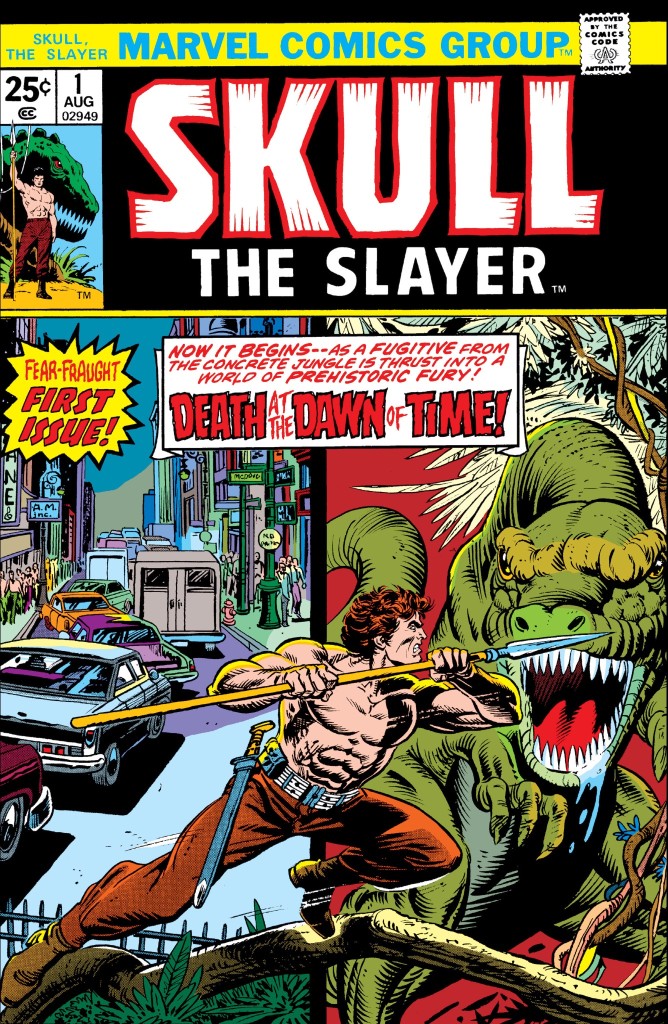
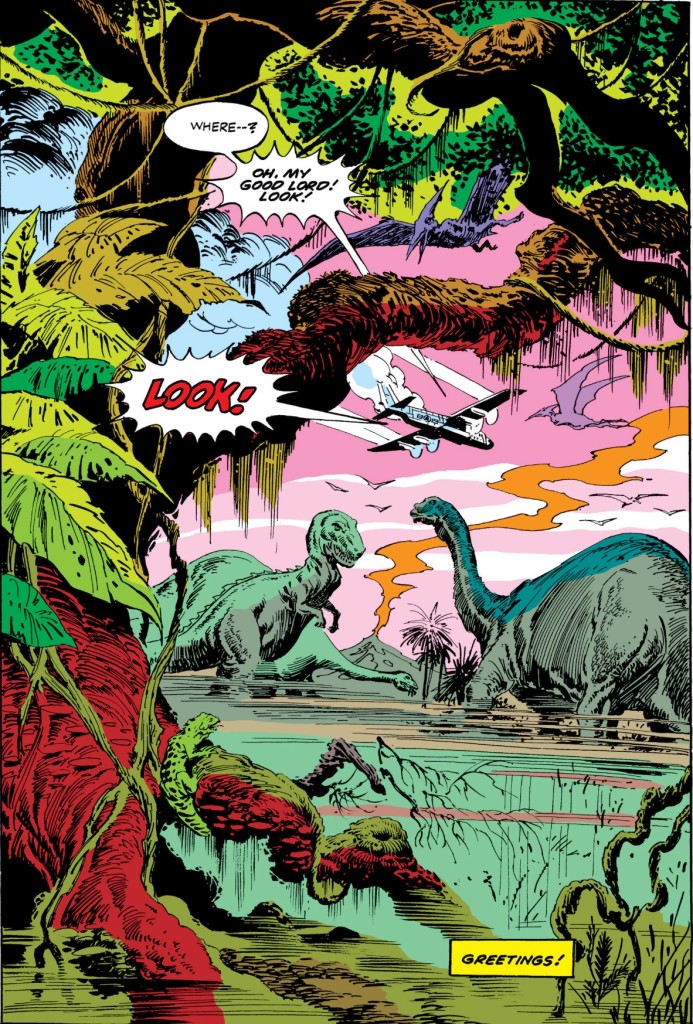
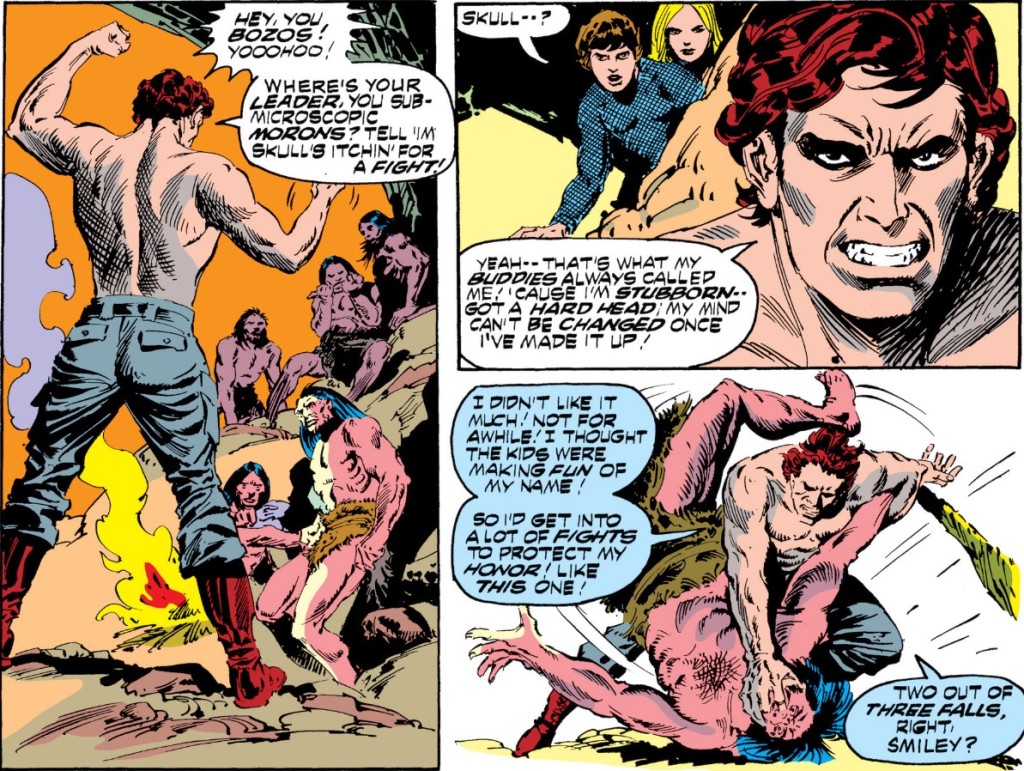
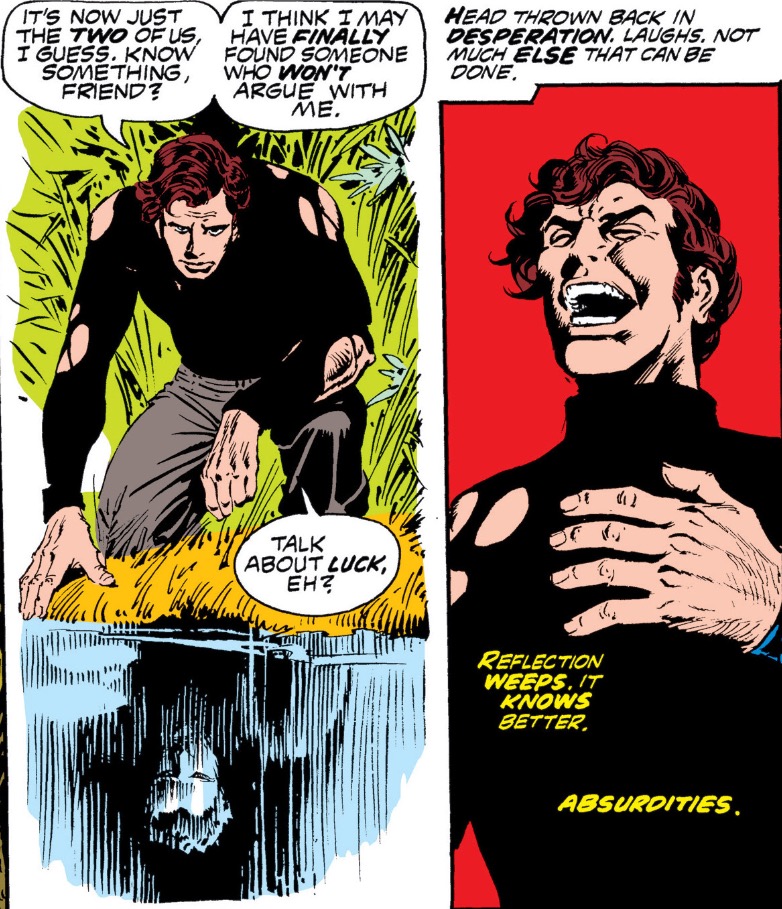
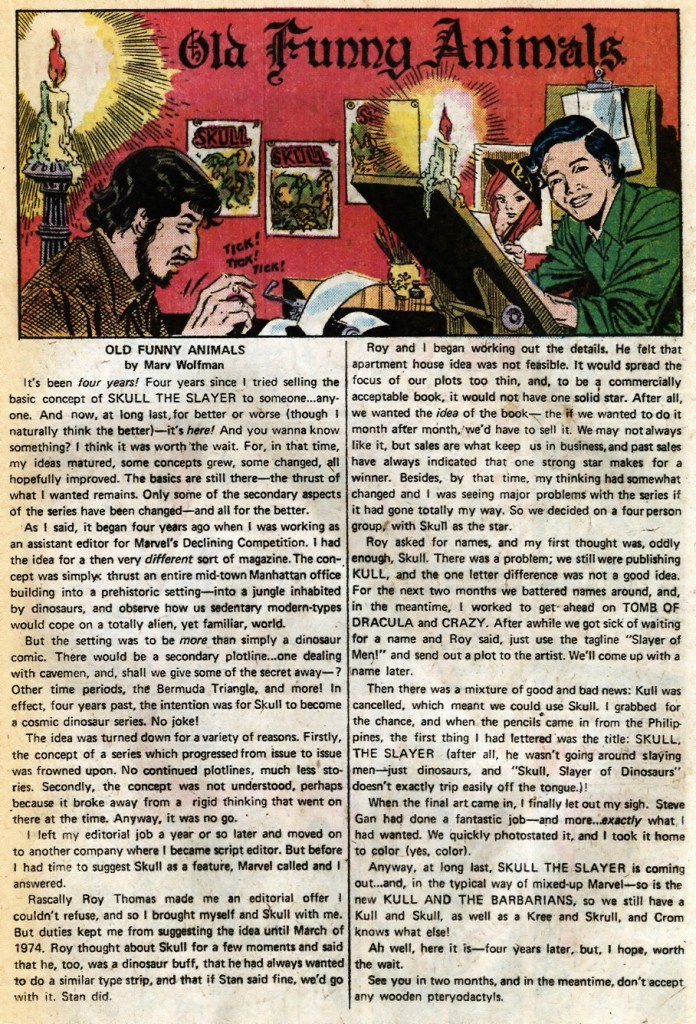
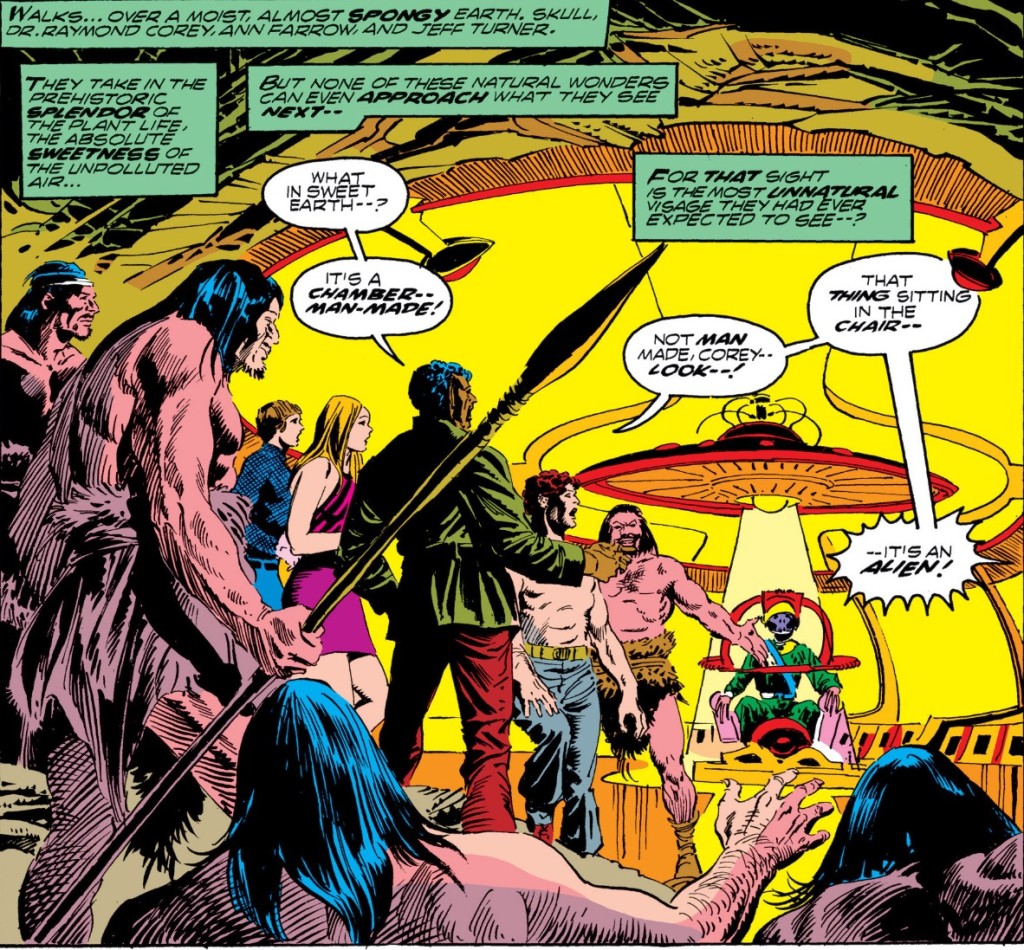
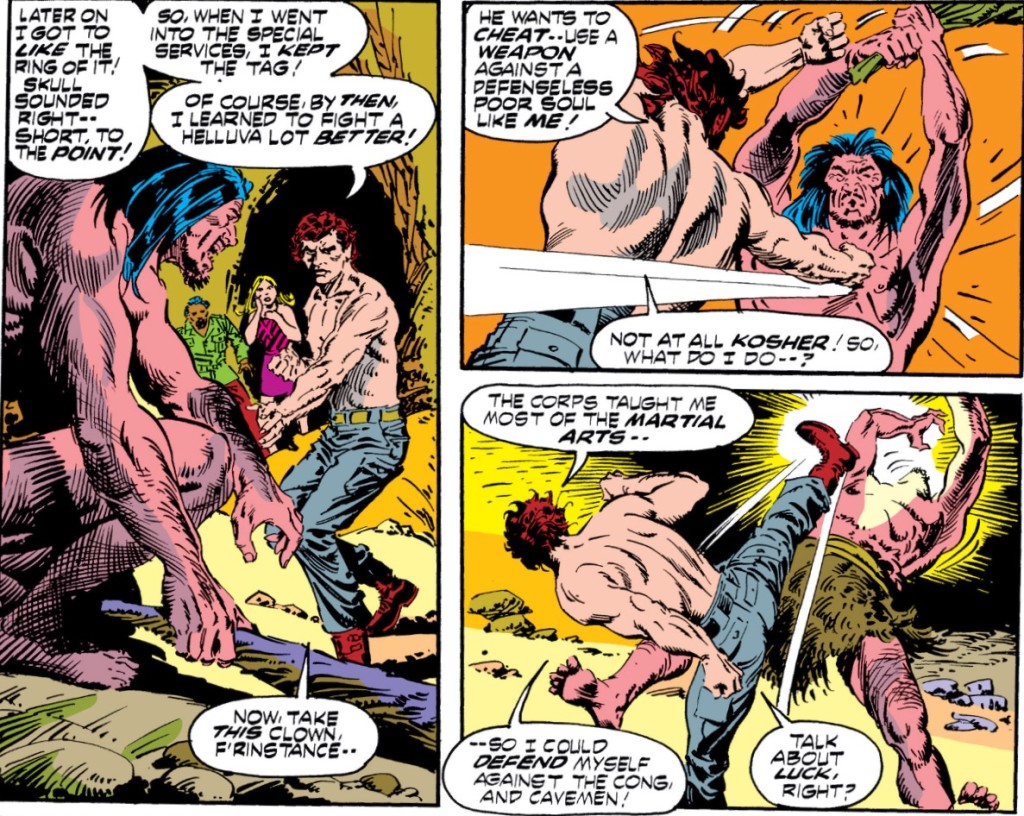
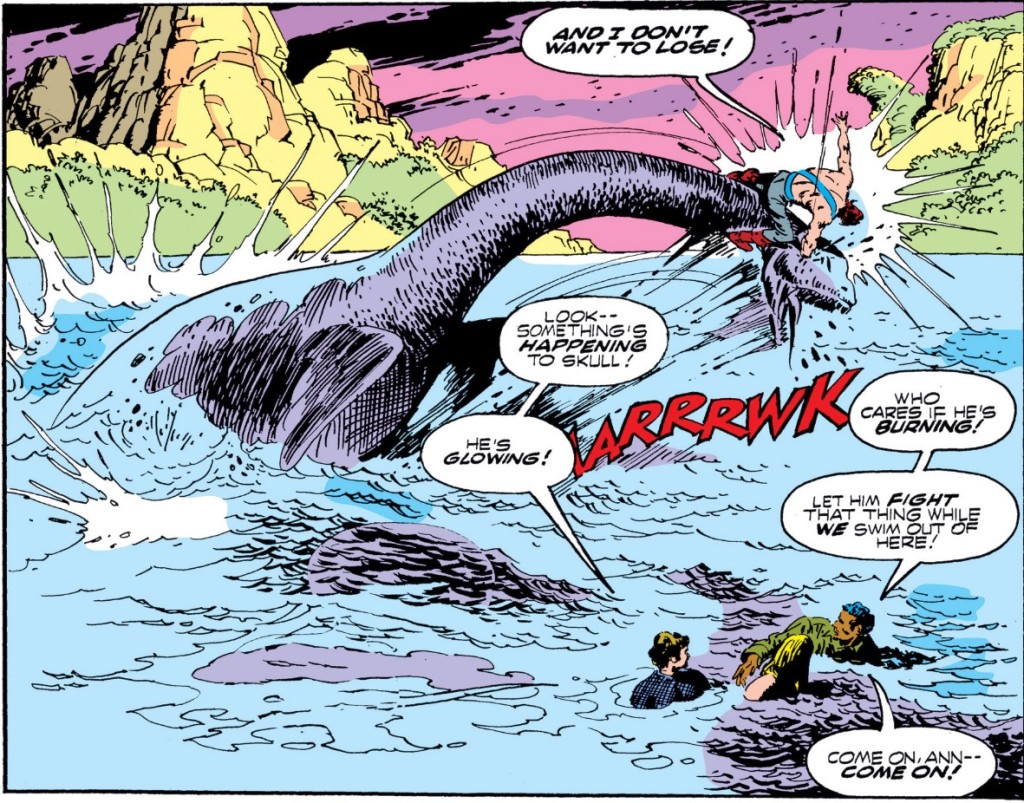


Interesting looking book. There is so much to unpack here that fits into my comics reading wheelhouse. I’ve never read this series but I’d like to. Of late, I’ve been obsessed with reading ’70s/’80s Marvel or DC fantasy/sci-fi series that I can find – it seems that most of them only lasted a handful of issues, like Skull (Starfire from DC is the one I’ve been reading – and relishing – of late, and like with Skull, Steve Englehart eventually came on board to take over the writing reigns, but could not save that series from early cancellation either).
When I was a kid, I always confused Skull with Kull, both from Marvel I believe. I used to see random back issues of each and was never sure which was which. I later learned that Kull was a Robert E. Howard property, so that helped to differentiate them in my mind. But even now, it still happens sometimes. Last week at my LCS, in the $1 bins I saw a stack of issues of Kull – I think! Or was it Skull?!? I’m pretty sure it was Kull…but I’m going to take another look next time I go to see if they’re still there and if they are actualy Skull, I might scoop ’em up. And even if they’re Kull, I might scoop ’em up.
As I was reading your synopsis of the series I couldn’t help think of – not only Lost but Mike Grell’s Warlord. Another fantasy series of that era I’ve never read but would love to at some point. I assume Warlord came about after Skull? I only the barest details of Warlord, but is it as similar in setup to Skull as it seems to me? I realize both series were just pulling into comics the sci-fi tropes of a stranger in a strange land, etc.
Did Steve Gan draw the first appearance of Star-Lord? I have the recent Star-Lord collection, so I could just look it up later, but I seem to recall he did, along with co-creating the character.
Yeah, if you check out the Wolfman text piece, you’ll see there was a certain worry about getting Skull and Kull confused, which they thought they worked out but then only screwed things up worse.
And thanks for mentioning Warlord—you’re absolutely right they have a lot in common, which is unsurprising because they’re both working the Edgar Rice Burroughs Pellucidar riff pretty hard.
And finally, you’re right about Gan being involved with Star-Lord in some capacity. If you check out the article I linked, Gan talks about looking forward to getting royalties from the work and wishing the Filipino comic industry was as progressive about such things as the American market (which is kinda sad).
Also, I have to say you convinced me: next time I’m hitting the back issue bins in Portland, I’m hunting down Starfire!
I hadn’t checked out the text piece until now – fascinating stuff. I love those old text pieces. Easily one of the things I miss most in modern comics!
I’m also looking forward to checking out that link to more about Gan, thanks for sharing that.
Well, I hope you enjoy Starfire if you find the issues. I fear I may be talking it up too much, but for some reason it’s hit the sweet spot for me and I’ve absolutely loved it. A real blast of seventies science fiction with wonderful art from Mike Vosburg. Unfortunately I think the series had 3 writers over the 8 issues! So it’s a bit inconsistent.
Oh man, I knew nothing about this book, but it sounds like one of those completely mad things they were doing at Marvel when no one was looking, and I’m already psyched to see what Englehart does to this.
Gonna have to track this down.
It’s pretty crazy but—at the risk of spoiling the next installment—Englehart basically tears everything apart and then leaves without putting anything together, which is almost completely unlike him. How that happens, maybe some speculation about why that happens, and what happens next may either totally convince you or put you off the book either way.
Weirdworld is also available digitally on Google Play for $9.99. I think the Google Play book reader handles double page spreads better than the Kindle app. (Plus you can usually download a book off of Google Play as a PDF or ePub. It’s usually a DRMed PDF or ePub, but at least you can get a local copy for backup purposes and aren’t at the whims of the cloud).
Thanks for the tip, Jer. I thought about mentioning the Kindle version of the Weirdworld trade also being available for $9.99 but didn’t because of the double page spread problem (actually, reading the reviews, the original black and white Weirdworlds had at least one triple page spread?) so it’s good to know about Google Play’s reader and the option for a backup copy. Totally stuff I was unaware of!
Marv Wolfman did such a good job handling the Tomb of Dracula and Teen Titans casts* that I’m surprised he didn’t do nearly as well with this comic. Also, I’m surprised I’ve never heard of Steve Gan. The art here looks like it could have followed Joe Kubert’s on Tarzan or Tor.
– Mike Loughlin
* except Changeling, one of the all-time worst comic relief characters. And friggin’ Terry Long.
Mike, for all that Changeling and Terry Long are bad, you cannot leave out the last, worst head on the Cerberus of bad Teen Titans characters: Danny Chase.
Dear God, how could I have forgotten the Cousin Oliver of the DCU?!
He’s just the worst. The. worst.
I don’t know what’s the bigger problem: that he was intentionally written to be unlikable with an eye towards an redemption that never came, or that DC spent an inordinate amount of time trying to “redeem” the character in various ways years after anyone cared. because dammit, every character is important.
He’s like a comics example of the sunk cost fallacy.
There are no bad characters; there is just IP that needs to be made viable for future media use.